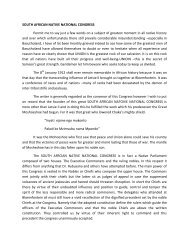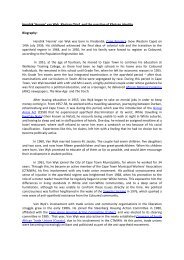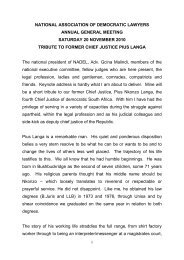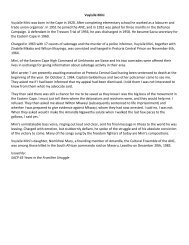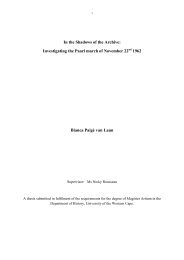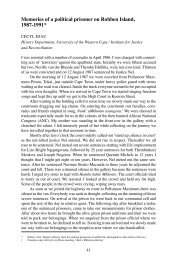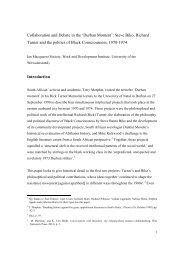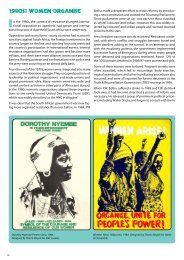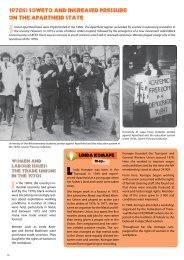Celebrating Women - South African History Online
Celebrating Women - South African History Online
Celebrating Women - South African History Online
Create successful ePaper yourself
Turn your PDF publications into a flip-book with our unique Google optimized e-Paper software.
<strong>Women</strong> in the<br />
workplace<br />
s<br />
outh <strong>African</strong> society remains a diverse<br />
and there are many challenges ahead.<br />
Motherhood is still central to most women’s<br />
lives and a woman’s role in family life<br />
is still the basis of a morally sound, orderly<br />
and cohesive society.<br />
Although great strides have been made,<br />
gender discrimination still takes place in<br />
the workplace, and while there are notable<br />
exceptions, women are still poorly represented<br />
in top managerial and executive<br />
posts countrywide.<br />
Organisations such as the Businesswomen’s<br />
Association of <strong>South</strong> Africa, who strive<br />
to provide ongoing opportunities to advance<br />
the interests of women in business,<br />
attest to the strides women have made in<br />
their struggle to shake off the shackles of<br />
the past against political oppression and<br />
gender inequality.<br />
Workers on the women’s poultry<br />
project. Inyavini, Kwazulu<br />
Natal. Photograph by Jeeva Rajgopaul.<br />
Ndaya water project. Umbumbulu, Kwazulu Natal. Photograph<br />
by Jeeva Rajgopaul.<br />
Role of NGO’s and Government institutions<br />
There are vibrant Non-governmental Organisations, like People Opposing <strong>Women</strong> Abuse (POWA) and <strong>Women</strong> Against <strong>Women</strong><br />
Abuse (WAWA), which were established in 1979 and 1989 respectively, to educate and support female victims of assault<br />
and rape. There are also NGOs, such as SONKE, who work towards promoting social cohesion between males and females in<br />
order to break the destructive cycle of violence.<br />
The government’s poverty alleviation programmes have become a key element in the consolidation of local government<br />
structures and the promotion of the principals of social, economic, cultural, civic and political rights of its citizens.<br />
One such programme is the government’s community based Public Works Program (EPWP). The programme aims to employ<br />
a million people by 2010. This programme was followed by the Expanded Public Works Program launched in April 2004.The<br />
programme is now in its second phase.<br />
In addition, the local chapter of the international organisation Business and Professional <strong>Women</strong> (BPW), a fairly new entity in<br />
<strong>South</strong> Africa, is set to launch a national campaign to bring about change in business principles and the Companies Act so that<br />
women will have more say in making decisions in the workplace.<br />
Classroom activity<br />
Make a poster<br />
The importance of the events of 1956 is remembered every<br />
year on 9 August, the day on which the women marched<br />
to Pretoria. In our new democracy, this day is celebrated as<br />
a holiday – National <strong>Women</strong>’s Day.<br />
1. Divide into groups and pretend you are going on a<br />
march on <strong>Women</strong>’s Day.<br />
2. In your group, discuss what the issues are for women<br />
today.<br />
3. Choose a message that your group would like to put on<br />
a poster.<br />
4. Discuss who your poster is aimed at and who your message<br />
is for.<br />
5. Now decide what words you are going to put on the<br />
poster. Try to keep your message simple and memorable.<br />
6. Decide what images or pictures you want to use. You<br />
can draw them or cut them out of magazines and paste<br />
them onto the poster. Make the relationship between the<br />
words and the pictures clear. People need to get the message<br />
at a glance.<br />
7. Design a rough poster before you attempt the final<br />
one.<br />
8. To test if your poster works, show your rough poster to<br />
another group and get their comments.<br />
9. Prepare your final poster and stick your posters onto the<br />
wall.<br />
35



